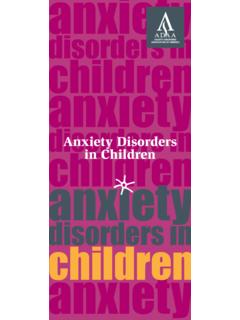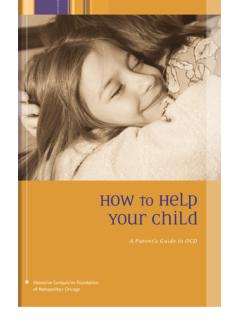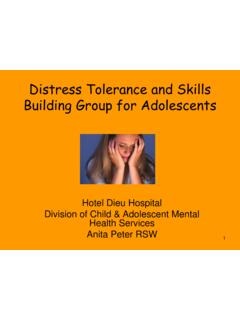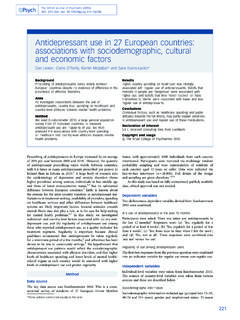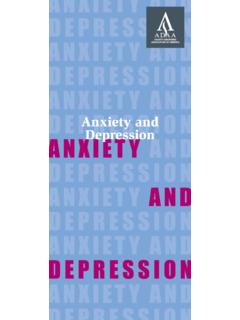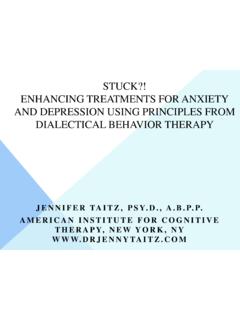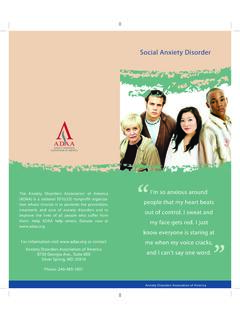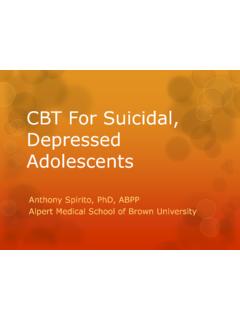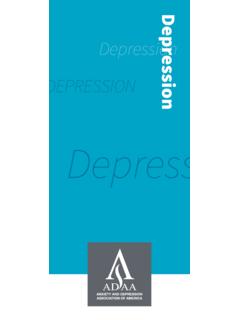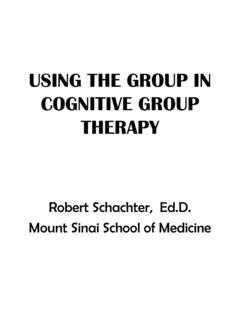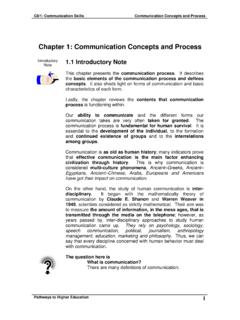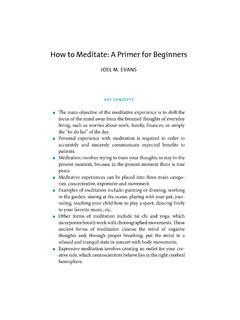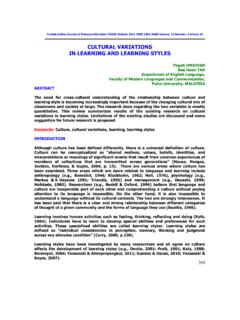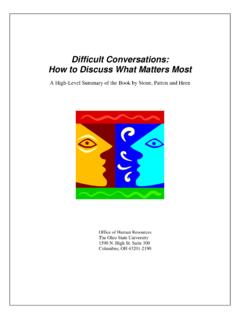Transcription of Using DBT Skills to Reduce Emotion Dysregulation in ...
1 Using DBT Skills TO Reduce Emotion Dysregulation AND REACTIVITY IN CHILDREN/ADOLESCENTS AND PARENTS Pat Harvey, LCSW-C, ACSW ADAA National Conference April,14, 2012 Pat Harvey, LCSW-C 1 2 Disclosure I have a relationship with New Harbinger Publications, the publisher of my book. I have a link on my website that results in my receiving a percentage of books bought through that link. I also receive royalties from PESI for presentations I have done that they continue to market. I have no other relationships to report. How DBT began Marsha Linehan found that a purely cognitive behavioral approach was ineffective in changing the behaviors of suicidal individuals; she searched for a more effective treatment and added several Zen Skills to her treatment approach: A focus on the present moment Acceptance of the individual in the moment She learned that acceptance was necessary for change.
2 Mindfulness practice and acceptance became distinguishing characteristics of DBT 3 Pat Harvey, LCSW-C 4 The central aim of DBT as a whole is to replace ineffective, maladaptive, or unskilled behavior with skillful responses (Linehan, 1993) In DBT, problem behaviors are seen as LEARNED RESPONSES to unbearable pain; impulsive behaviors are actually highly effective Emotion regulation strategies. A belief in the client s essential desire to grow and progress , as well as a belief in her inherent capability to change, underpins the treatment (Linehan, 1993) DBT focuses on doing what is effective what helps the person reach his/her goals. The mental health professional says, Tell me where you want to go and I will tell you how to get there This framework provides hope for parents and lessens their sense of hopelessness and helplessness.
3 Pat Harvey, LCSW-C MINDFULNESS PRACTICE WRITE YOUR NAME How do you hold your pencil? How much pressure do you use? Do your fingers? Does your whole hand move? What is your other hand doing? Pat Harvey, LCSW-C 5 Mindfulness Exercise Follow-up How did it feel? What did you notice? What did you learn? Did you recognize something you did not expect? Parents who practice this exercise learn to observe interactions and slow down their responses, giving them time to find an effective response. Pat Harvey, LCSW-C 6 MINDFULNESS Mindfulness is paying attention in a particular way; on purpose, in the present moment, and non-judgmentally. Jon Kabat-Zinn States of Mind 8 WISE MIND Reasonable Mind Emotion Mind 9 MINDFULNESS Reasonable Mind Plans and evaluates logically; Is planful in actions; thinks things through; Is easier to maintain when you are feeling good.
4 Emotion Mind Thinking and behavior are controlled primarily by emotions; Logical thinking is difficult; Facts may be distorted to fit with the affect. Pat Harvey, LCSW-C 10 Wise Mind Emotions cannot be controlled by intellect or vice versa they need to be integrated; Intuitive something that feels right , that feels like the truth; Being able to see the whole picture very clearly; When you can feel at peace with a decision feel centered . Pat Harvey, LCSW-C Adolescents Are driven by what they feel they need in Emotion Mind Might mask their emotions or otherwise appear competent in reasonable mind Think about the most effective way to handle a situation in Wise Mind Parents React in Emotion Mind Lecture or give explanations in Reasonable Mind Respond in Wise Mind We ask clients to ask themselves what Wise Mind would do and wait for the answer.
5 Pat Harvey, LCSW-C 11 12 What Skills Observe - attend, experience in the moment without words Let thoughts come in and go out, Noticing, sensing, attending. Describe - apply verbal labels necessary for communication and self-control, Use words , label what is observed, but do not judge, Describe a thought recognize that it is a thought , not a fact, Use words to represent what you observe. Participate - without self-consciousness, with attention. Throw oneself totally into something, The ultimate goal: entering wholly into an experience. Pat Harvey, LCSW-C 13 How Skills Nonjudgmentally do not evaluate, Can look at consequences vs. being evaluative about the behavior, oYour behavior is awful vs. your behavior is hurting me. One mindfully - focus on one activity at a time with awareness, Focus attention on only one thing in the moment washing dishes, talking on the phone, listening to music Effectively - doing what works what helps reach goals, Do not focus on what might be right vs.
6 Wrong , fair vs. unfair , Reacting to the reality of the situation, not what we wish the situation was. Enables parents and their children to assess and not judge their own and each other s behaviors based on whether or the behaviors help them reach their goals Pat Harvey, LCSW-C 14 NON-JUDGMENTAL LANGUAGE: NON BLAMING ATTITUDE The language we use is important in determining how we perceive people and their behaviors and how we feel about them. The words we use impact: The tone of our work; Our feelings about and responses to clients; Parents feelings about and responses to his/her child. Changing language helps to change attitudes and feelings. Judgmental language makes us angry, frustrated disappointed When you are less judgmental, you will feel calmer and more accepting Pat Harvey, LCSW-C 15 Non-judgmental language: Is non evaluative - does not carry positive or negative connotations.
7 Describes in detail does not label. Describes the behavior or situation in front of you so that someone else can see it the same way you do You can only describe what you can observe. oNo one has ever observed: Other s intentions Other s thoughts Other s feelings Causes Reasons Meanings Pat Harvey, LCSW-C 16 Judgments are often short-hand for stating consequences: giving up judgments does not mean denying consequences Non-judgmental language does: Look at the consequence of the behavior. For example: o When you act that way, I feel sad. o If you behave that way, you may be suspended. o If you do not change your behavior, you may not get what you want or meet your goals. Allow for preferences and opinions Pat Harvey, LCSW-C 17 Non-judgmental language also: Does not make assumptions about individuals, behaviors or motives; Does not assume the intent of the behavior; oDoes not assume that the intent of behavior is to impact someone else in a negative way; Separates the effect of the behavior from its assumed intent; oRegardless of how the observer FEELS because of the behavior, assumptions cannot be made about the INTENTION of the behavior.
8 Is important for clinicians and for parents to learn and practice; it minimizes feelings of anger, frustration and disappointment. Pat Harvey, LCSW-C 18 DIALECTICS In Dialectical Behavior Therapy an individual: Learns that two things that seem contradictory can both be true Learns to move from thinking in polarities, black and white (either/or) and extreme thinking to finding ways to entertain and integrate contradictory thoughts -that include: oThe need to accept oneself AND the need to change; oGetting what one needs AND not losing what one needs if one becomes more competent; oMaintaining personal integrity and validating one s own view of oneself and one s suffering AND learning new Skills that enable one to move beyond suffering. Finds ways to accept BOTH sides of a situation and find a synthesis that does not negate the reality of either.
9 O The middle path is not halfway between extremes but a completely new path oThe middle path is very important in families between parents and children and between each of the parents. Pat Harvey, LCSW-C 19 BALANCING ACCEPTANCE AND CHANGE This is DBT s Core Dialectic and Using it is key to effectiveness DBT balances Two Truths oYou can accept an individual as he/she is in this moment AND oExpect him/her to change and make his/her life better In DBT, there will be a focus on: Helping clients to increase their ability to accept and tolerate painful feelings, their current life situations and themselves AND Helping clients learn new Skills and behaviors that will enhance life. Acceptance is necessary for change This is true for the parents as well as for the adolescent Pat Harvey, LCSW-C 20 Balanced Thinking Avoids all or none, accepts both Acceptance and hope (Parents often feel that if they accept they give up hope; this dialectic needs to be re-enforced so they do not become hopeless) Independence and assistance Choices and limits Giving in and choosing priorities Firmness and gentleness Pat Harvey, LCSW-C Balanced language avoids extreme words Avoid extreme words Minimize use of always, never, everyone, nobody Use sometimes, occasionally Help clients to use less extreme or absolute words When you change language and minimize absolute language, parents and kids are less angry, disappointed and frustrated.
10 There is more possibility of hope Pat Harvey, LCSW-C 21 22 As a professional you balance understanding your clients behavior in the context of their life AND helping them to learn Skills to manage their behaviors better. An emphasis either on acceptance or on change is usually ineffective In DBT, clients are told: I see how you feel that way. Now what can we do to make things different or to help you feel better? It is important to remember, and to remind your clients, that behaviors have been learned; they can be unlearned and new behaviors can be learned to replace them. The acceptance that someone is doing the best he/she can in the context of his/her life is as true for parents as for the adolescent . DBT Balance and Clients Pat Harvey, LCSW-C VALIDATION To Move to Change, You Have to First Accept Validation means letting someone know you: Are listening; Understand how he/she feels; Are taking him/her seriously; Are understanding his/her behavior within the context of his/her life circumstances; Accept him/her.
